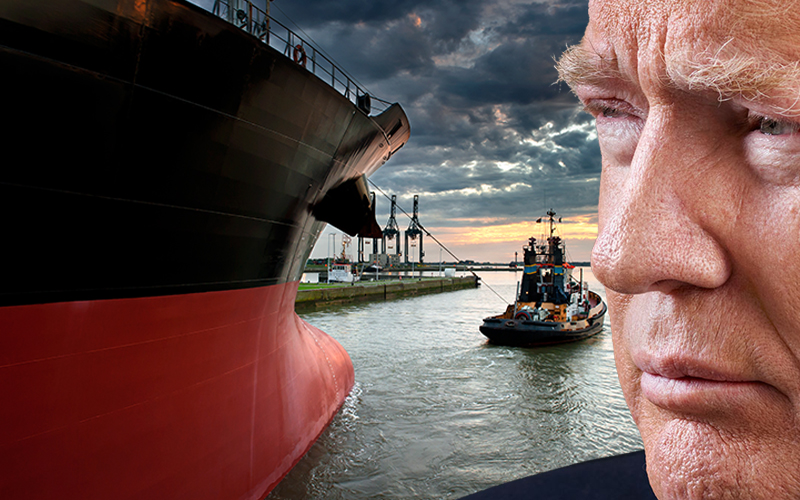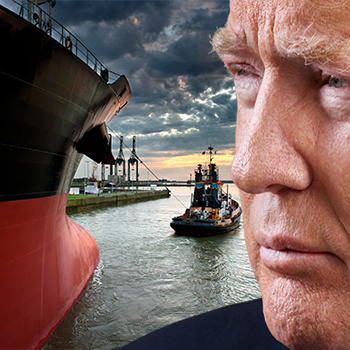AAPA Provides Trump Transition Team with Port Industry’s Policy Platform Recommendations

Ports platform includes land & water freight transportation investments, port security and environmental enhancements.
The American Association of Port Authorities (AAPA) - the recognized and coordinated voice of seaports in the Americas - last week sent a multi-faceted document to President-Elect Donald Trump’s transition team.
The paper outlines opportunities to, in the words of the president-elect’s campaign, “Make America Great Again,” by strategic investments in seaports and related freight transportation assets, thereby helping U.S. businesses better compete in markets at home and abroad.
“President-Elect Trump has put forth an ambitious goal of investing up to $1 trillion to rebuild America’s infrastructure, for which freight transportation and ports are vital components,” said AAPA President and CEO Kurt Nagle.
“An enhanced focus on freight transportation and ports would help achieve the new administration’s goal of building a better economic future for America.”
Among some of the key recommendations laid out by AAPA are:
- Relieve traffic bottlenecks and expand capacity by: providing additional FAST Act investments and a sustainable freight trust fund to plan and build multimodal projects; establishing a properly funded and staffed Office of Multimodal Freight Transportation within the U.S. Department of Transportation’s (USDOT) Office of the Secretary; supporting funding for a robust StrongPorts program under the USDOT Maritime Administration to help ports plan for their 21st century infrastructure needs; increasing investments for authorized marine highway projects to ensure transportation alternatives alongside congested landside transportation corridors; and increasing funding for transportation infrastructure grants to $1.25 billion per year.
- Modernize and fully maintain federal navigation channels by: making harbor maintenance tax (HMT) spending a priority; continuing the goal toward full use of the HMT; ensuring equity and fairness of HMT distributions; increasing funding for HMT maintenance spending in the FY2018 budget request, including funding for Donor and Energy Transfer Ports; devising a permanent solution as part of tax reform or other legislation for ensuring all annual HMT revenues are spent; increasing federal investment in navigation channel deepening and widening; improving efficiencies in the deep-draft study and construction process; continuing progress to finish navigation projects in a timely manner to better compete in world markets; and providing operations and maintenance funding for the National Oceanic and Atmospheric Administration’s Physical Oceanic Real-Time System, or “PORTS,” to help mariners navigate safely.
- Secure America’s ports and waterside borders by: increasing the Federal Emergency Management Administration’s Port Security Grant Program (PSGP) funding level to at least $100 million per year; directing grant funding to ports rather than to other entities with very low commercial seaport threats; continuing the management and control of the PSGP at the federal level; providing 500 additional Customs and Border Protection (CBP) maritime staff to U.S. seaports to meet trade needs and ensure cargo is safe and moves efficiently; getting adequate federal funding to purchase, install and maintain Radiation Portal Monitors (RPM) within ports throughout the U.S.
- Help protect the environment and build resilience by: increasing funding for the Environmental Protection Agency’s Diesel Emissions Reduction Act (DERA) program; creating a 21st Century Port Portfolio within the Department of Energy (DOE) that allows ports and the DOE to partner on new technologies that reduce air emissions, connect ports to the grid, provide electrification opportunities for port operations, and provide support and expertise for new clean energy terminal designs and build-outs; and ensuring federal agency programs that address natural disasters and coastal erosion include assistance to seaports to help predict, plan and adopt mitigation strategies.
“Nations worldwide have recognized the need to invest significantly in their freight networks to accommodate increasing volumes, larger vessels and be competitive,” said Mr. Nagle.
“It’s vital that the United States invest significantly in its ports and freight network.”
“America’s seaport activity accounts for over a quarter of the national economy and supports more than 23 million jobs. Local ports and their private-sector partners plan to invest nearly $155 billion into infrastructure over the next five years. Leveraging federal investments in seaport and freight-related programs will yield huge dividends in the form of economic growth, maintaining and creating jobs, enhancing America’s international competitiveness and sustaining a healthy environment.”
Related Article: Trump Promises to Withdraw From the Trans-Pacific Partnership on Day One
Article Topics
American Association of Port Authorities News & Resources
AAPA and MARAD team up for survey focused on identifying port cargo handling needs Q&A: Cary Davis, American Association of Port Authorities President and CEO-elect AAPA’s Chris Connor Gives Overview of United States Ports Port-focused initiatives are major driver for White House in Infrastructure Investment and Jobs Act Ocean shipping issues are in the spotlight in letters to the White House LM Podcast Series: AAPA’s Connor Examines the State of U.S. Ports House T&I Committee and AAPA praise passing of the Water Resources Development Act (WRDA) of 2020 More American Association of Port AuthoritiesLatest in Transportation
Baltimore Bridge Collapse: Impact on Freight Navigating Amazon Logistics’ Growth Shakes Up Shipping Industry in 2023 Nissan Channels Tesla With Its Latest Manufacturing Process Why are Diesel Prices Climbing Back Over $4 a Gallon? Luxury Car Brands in Limbo After Chinese Company Violates Labor Laws The Three Biggest Challenges Facing Shippers and Carriers in 2024 Supply Chain Stability Index: “Tremendous Improvement” in 2023 More Transportation















